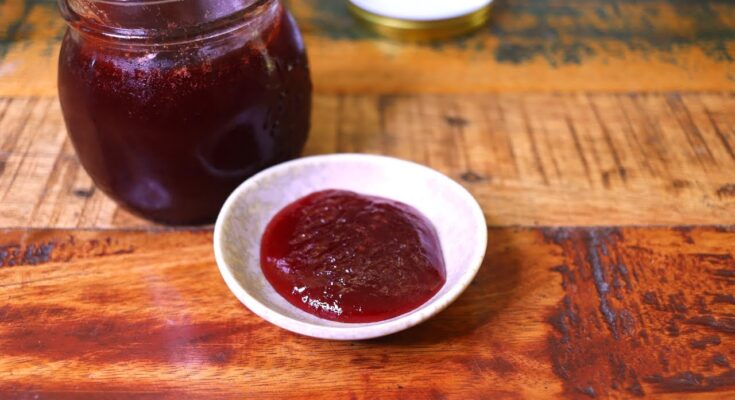Plum Jam Recipe: Ever had a spoonful of store-bought jam that tasted more like sugar than fruit? That’s one big reason to go homemade. Plum jam made from scratch doesn’t just burst with flavor—it’s also packed with the natural richness and subtle tartness of fresh, ripe plums. Making it yourself means you know exactly what’s going into your food: no artificial preservatives, no high-fructose corn syrup, just juicy plums, a little sugar, and a whole lot of love.
Beyond taste, making plum jam is surprisingly therapeutic. From slicing fruit to stirring the simmering pot, the entire process is simple yet incredibly satisfying. It gives you a deep sense of connection to your food and the joy of turning basic ingredients into something extraordinary. Homemade jam also makes fantastic gifts and adds a personal, artisanal touch to your breakfast table.
Nutritional Benefits of Plums
Let’s not forget the health perks. Plums are loaded with antioxidants, particularly phenols, which help protect the body against oxidative stress. They’re also high in fiber, especially if you leave the skins on (which you should), and provide vitamin C to boost immunity. This fruit is naturally low in calories and has a low glycemic index, making plum jam—when made without excessive sugar—a healthier option for spreads.
When you make your own plum jam, you have full control over sugar levels and can even experiment with natural sweeteners like honey or stevia. So not only is it tasty, but it can also be a smart choice for anyone looking to enjoy something sweet without going overboard.
Ingredients You’ll Need
Best Plums for Jam-Making
Choosing the right type of plum is step one. Not all plums are created equal, especially when it comes to jam. For a rich, flavorful jam, go for:
- Italian Prunes (or Prune Plums) – These are small, deep purple, and sweet-tart, perfect for jam.
- Santa Rosa Plums – Slightly larger and juicier, with a bright flavor and red skin.
- Damsons – Known for their intense tartness and deep color; great if you like a tangier jam.
The key here is ripeness. Use plums that are soft and sweet, but not overripe or mushy. Overripe fruit can lead to a watery jam that won’t set well.
Other Key Ingredients
You really only need a few other items:
- Sugar – Acts as both a sweetener and a preservative. For every pound of plums, you’ll typically use ¾ to 1 cup of sugar.
- Lemon Juice – Adds natural pectin and balances the sweetness.
- Optional: Pectin – Speeds up setting and gives you a firmer consistency, though it’s not necessary with pectin-rich plums.
That’s it. Three simple ingredients, and you’re on your way to the best jam you’ve ever had.
Essential Equipment
Tools You’ll Need in the Kitchen
Making jam doesn’t require any fancy equipment, but there are a few essentials that’ll make the process easier:
- Large heavy-bottomed pot – Prevents burning and allows even cooking.
- Wooden spoon or silicone spatula – For stirring the mixture.
- Sterilized jars with lids – For canning and storage.
- Jar funnel – Helps pour jam neatly into jars.
- Ladle – To scoop out the hot jam.
- Thermometer (optional) – Helps check if your jam has reached the setting point (220°F or 104°C).
These basics are more than enough to get you started, and you probably already have most of them in your kitchen.
Prepping Your Workspace
Before you start cooking, lay out all your tools, clean your work surface, and wash your jars thoroughly. Sterilizing your jars beforehand (we’ll cover this later) is crucial. Having everything ready before you turn on the stove means you’ll be less likely to overcook or burn the jam because you’re scrambling to find a missing ladle or jar lid.
Keep a clean towel nearby, and make sure you have a hot pad or trivet for placing your jars after filling. A little prep now saves a lot of hassle later.
Preparing the Plums
Washing and Cutting the Fruit
Wash your plums thoroughly under cold running water to remove any dirt or pesticides. Even if you bought organic, it’s good practice. Don’t peel the plums—the skin adds both flavor and natural pectin, which helps the jam set.
Next, cut each plum in half and remove the pits. If you’re working with smaller plums, you might want to quarter them for faster cooking. For a chunkier jam, leave larger pieces; for a smoother texture, chop more finely.
Want a little twist? Add some finely grated orange zest or a splash of vanilla extract at this stage for added complexity in the flavor profile.
Removing the Pits Efficiently
The quickest way to pit a plum? Use your fingers or a small paring knife. If the fruit is ripe enough, the pit should slide right out. Some people use cherry pitters, but that’s not necessary unless you’re working with a huge batch.
You can even save the pits and boil them in a cheesecloth bundle during cooking, then remove them before canning. This infuses a mild almond-like flavor thanks to the natural compounds in plum pits.
Cooking the Plum Jam
Boiling and Simmering the Mixture
Alright, it’s time for the real magic to happen. Once your plums are pitted and chopped, toss them into your large, heavy-bottomed pot. Add your sugar and lemon juice, and give it a good stir to combine. If you’re using pectin, hold off on adding it until the jam has cooked for a bit—most types are added at a specific stage, so always read the label.
Turn the heat to medium and let the mixture gradually warm up. You’ll notice the fruit releasing its juices, forming a thick syrup. Stir frequently to prevent any sticking or burning at the bottom. Once the mixture starts bubbling, reduce the heat slightly and let it simmer. This step usually takes around 20 to 40 minutes, depending on your batch size and how thick you want your jam.
The longer it simmers, the deeper the flavor. Just make sure to stir often and skim off any foam that forms on top—it won’t hurt the taste, but removing it gives you a clearer, more polished jam.
Monitoring the Right Consistency
So how do you know when it’s ready? There are a few classic ways:
- The Freezer Plate Test: Place a small plate in the freezer before you start. When you think your jam is ready, drop a bit on the cold plate. Wait a few seconds, then run your finger through it. If the jam wrinkles and stays separated, it’s done.
- Use a Thermometer: Jam sets at 220°F (104°C). Once your mixture hits that temperature, you’re golden.
- Visual Cues: The jam should look glossy and coat the back of a spoon. Run your spoon through the pot—if the mixture parts and doesn’t immediately fill back in, it’s set.
Once you’re happy with the texture, take the pot off the heat. Let it cool slightly before canning.
Sterilizing and Canning the Jam
Step-by-Step Canning Process
Canning might sound intimidating, but it’s actually super easy once you do it once or twice. First, you need to sterilize your jars. Here’s how:
- Boil Them: Place your jars in a large pot, cover with water, and boil for 10 minutes. Keep them in the hot water until you’re ready to fill.
- Boil the Lids Separately: Add the lids and rings to a smaller saucepan of hot (not boiling) water and keep them warm.
Now, let’s fill those jars:
- Use your ladle and jar funnel to pour the hot jam into each jar, leaving about ¼ inch of space at the top.
- Wipe the rims with a clean, damp cloth.
- Place the lids on top, then screw on the rings—not too tight.
Now for the final step—processing. This ensures your jam is shelf-stable:
- Place the filled jars back into your boiling water canner or large pot. Make sure they’re covered by at least 1 inch of water.
- Boil for 10 minutes (adjusting for altitude if needed).
- Carefully remove the jars using tongs and place them on a towel. Let them cool completely.
You’ll hear the satisfying “pop” as the lids seal. Once cool, check the seals by pressing down on the center of each lid—if it doesn’t move, you’re good to go!
Proper Storage Tips
Once sealed, your jam can be stored in a cool, dark place for up to one year. After opening, keep it in the fridge and use within 3 to 4 weeks.
Label your jars with the date and contents—you’ll be surprised how quickly you go through them. If any jar didn’t seal properly, no worries. Just pop it in the fridge and use it first.
Tips for the Perfect Plum Jam
Troubleshooting Common Issues
Not every jam turns out perfect the first time, and that’s okay. Here’s how to fix the most common hiccups:
- Too Runny? Simmer it longer next time or add a bit of commercial pectin.
- Too Thick? It was probably cooked a little too long. You can stir in a bit of boiled water to loosen it before using.
- Too Sweet or Too Tart? Adjust the sugar or lemon juice to your taste. You can also add a pinch of salt to balance out excessive sweetness.
- Jam Didn’t Set? Re-boil it with a bit of added pectin or lemon juice. You don’t have to toss the whole batch!
Making jam is a bit of science mixed with a lot of art. Don’t worry if it’s not perfect—it’ll still taste great.
Flavor Enhancements and Variations
Want to get a little fancy? Try these additions to elevate your plum jam:
- Cinnamon or Nutmeg – Adds warmth and spice.
- Vanilla Extract – A splash goes a long way for depth.
- Chili Flakes – For a sweet and spicy twist.
- Orange or Lemon Zest – Brightens the flavor.
- Ginger – Fresh or ground, it pairs beautifully with plums.
You can also mix in other fruits like apricots, peaches, or raspberries for custom blends.
Creative Ways to Use Plum Jam
Breakfast, Snacks, and Desserts
You’ve got your jars of jam—now what? Spread it on toast? Sure, but that’s just the beginning.
Here are some mouthwatering ideas:
- Stir into oatmeal or yogurt for a fruity punch.
- Drizzle over pancakes, waffles, or crepes.
- Use as a glaze for meats like pork or chicken.
- Make thumbprint cookies or swirl it into cheesecake batter.
- Pair with cheese and crackers—especially brie or goat cheese.
There are endless ways to incorporate plum jam into your meals and desserts. It’s sweet, tangy, and ridiculously versatile.
Gift Ideas Using Homemade Jam
Homemade plum jam makes an incredible gift. Dress up your jars with a bit of rustic twine, a handwritten label, and a small tag with serving suggestions.
Some fun gift ideas include:
- Jam gift baskets with crackers, tea, and cheese.
- Wedding or party favors in mini jars.
- Holiday gifts paired with fresh baked bread or muffins.
People love thoughtful, handmade gifts—and they’ll definitely remember yours.
FAQs about Plum Jam Recipe
1. Can I use any type of plum for this jam?
Yes, you can use any variety of plums—red, black, yellow, or even wild plums. Each type brings a unique flavor and color to your jam, so feel free to experiment!
2. Do I need to peel the plums?
No, peeling is not necessary. Plum skins soften during cooking and help add natural pectin, which aids in thickening the jam.
3. How long does homemade plum jam last?
When properly sealed and stored in a cool, dark place, your jam can last up to 12 months. Once opened, keep it refrigerated and consume within 3–4 weeks.
4. Can I make plum jam without pectin?
Absolutely! Plums are naturally rich in pectin, so most recipes don’t require added pectin. Just cook the mixture until it reaches the right thickness.
5. How do I know when the jam is set?
Use the “wrinkle test”—drop a spoonful of jam onto a cold plate, wait a few seconds, then push it with your finger. If it wrinkles, it’s ready.
6. Can I reduce the amount of sugar?
Yes, but keep in mind that sugar helps with both preservation and texture. Reducing it too much may shorten shelf life or change the consistency.
7. Is plum jam freezer-friendly?
Yes! You can freeze plum jam in airtight containers for up to 6 months. Just leave a bit of space at the top for expansion.
Conclusion
What makes this process so rewarding isn’t just the end product—though that’s undeniably delicious—but the experience itself. From handpicking the perfect plums to stirring the pot and hearing those lids “pop” as they seal, every step brings a sense of satisfaction and accomplishment. And let’s not forget how impressive it feels to share a jar of jam that you made with your own hands.
So whether you’re preserving a bumper crop, exploring a new hobby, or simply want a break from store-bought sugar bombs, this plum jam recipe has got you covered. Don’t be afraid to experiment with flavors, play with textures, and create a jam that’s uniquely yours.
Next time you find yourself with a basket of ripe plums, skip the store and make magic in your own kitchen.



